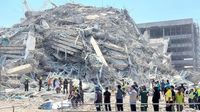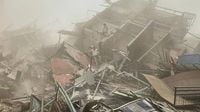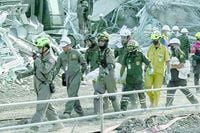On March 28, 2025, a devastating earthquake measuring 7.7 on the Richter scale struck northwest of Sagaing, Myanmar, claiming the lives of over 1,600 people and causing widespread destruction across the region. This unprecedented disaster has left the country reeling, with thousands injured and many more trapped beneath the rubble of collapsed buildings.
Minutes after the initial quake, a powerful aftershock of 6.4 magnitude further exacerbated the chaos, prompting urgent rescue efforts as officials scrambled to locate survivors. According to the military council, the death toll has officially reached 1,644, with 3,408 individuals reported injured, predominantly in Mandalay, Myanmar's second-largest city and the hardest hit by the tremors.
The scale of destruction is staggering, with reports indicating that buildings, homes, religious sites, and infrastructure have been severely damaged or completely destroyed. Eyewitnesses described scenes of devastation as entire neighborhoods were flattened, leaving many citizens in shock and fear of further disasters. “It was terrifying,” recounted Ba Tshit, a 55-year-old Mandalay resident. “My family is fine, but others were affected. I feel very sad because of what happened.”
Relief workers have been tirelessly working to rescue those trapped in the debris, particularly in the Sky Villa residential complex, where over 90 individuals are believed to be still buried. The challenges faced by these teams are compounded by widespread power outages and disrupted communication lines, making it difficult to coordinate rescue operations effectively.
In response to the crisis, the ruling military council has declared a state of emergency in the most affected areas, with General Min Aung Hlaing making a rare appeal for international assistance. Historically, the military government has been reluctant to accept foreign aid, but the magnitude of this disaster has compelled them to seek help from the international community. “We need help. Everything is being taken from us,” lamented 68-year-old resident Thar Aye, highlighting the dire situation on the ground.
Countries across the globe have stepped up to offer assistance. China has pledged to send 82 rescue workers and provide $13.8 million in humanitarian aid, while India has dispatched a plane loaded with personal hygiene supplies, blankets, and food. The Philippines announced it will send a team of 114 people, including medical personnel and firefighters, to aid in rescue efforts.
Furthermore, humanitarian organizations like the World Health Organization are activating emergency response systems to assist with medical needs. The Irish Foreign Minister, Simon Harris, has announced a commitment of €6 million in humanitarian aid, with half allocated for the International Red Cross’s operations in Myanmar.
In addition to the devastation in Myanmar, the earthquake's impact was felt across the border in Thailand, where buildings were damaged, and several fatalities were reported. In Bangkok, search teams have been working overnight to locate survivors under the rubble of a collapsed construction site. Governor Chadchart Sittipunt reported that about ten people have died in the Thai capital, primarily at the construction site, but warned that the toll could rise as rescue efforts continue.
The situation remains critical as authorities assess the full extent of the damage. Initial estimates suggest that the death toll could exceed 10,000, with the economic impact potentially surpassing the country’s GDP. The United Nations has warned that Myanmar is ill-prepared to cope with a disaster of this scale, particularly given the ongoing internal conflict that has displaced millions and severely weakened the healthcare system.
As rescue operations continue, the global community watches closely, hoping for swift action and support for the people of Myanmar during this unprecedented crisis. The road to recovery will be long and fraught with challenges, but the international response signals a commitment to aiding those in need during this tragic time.






